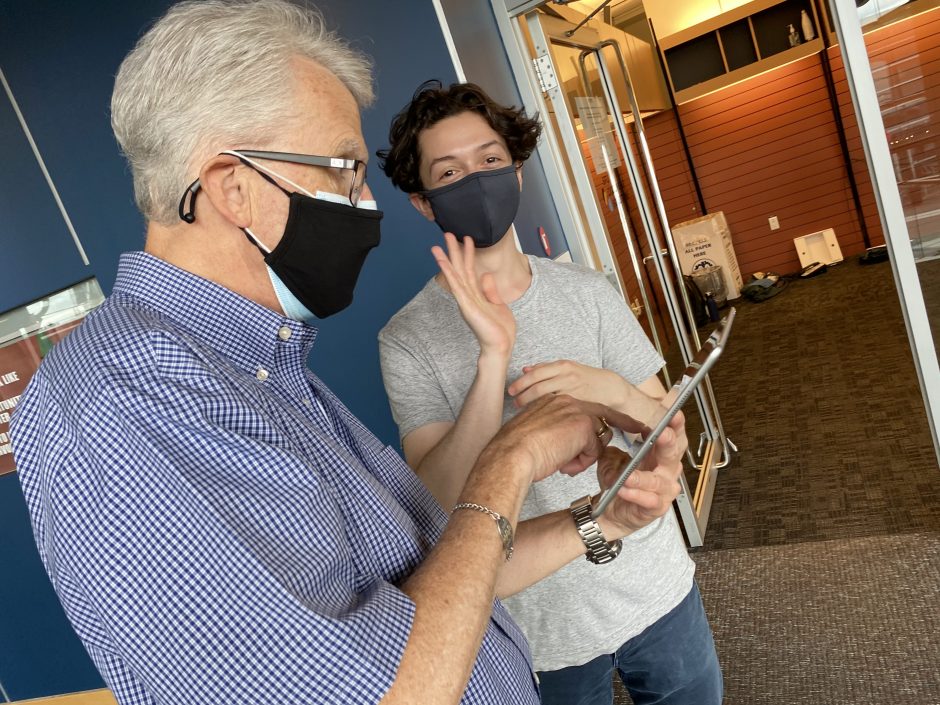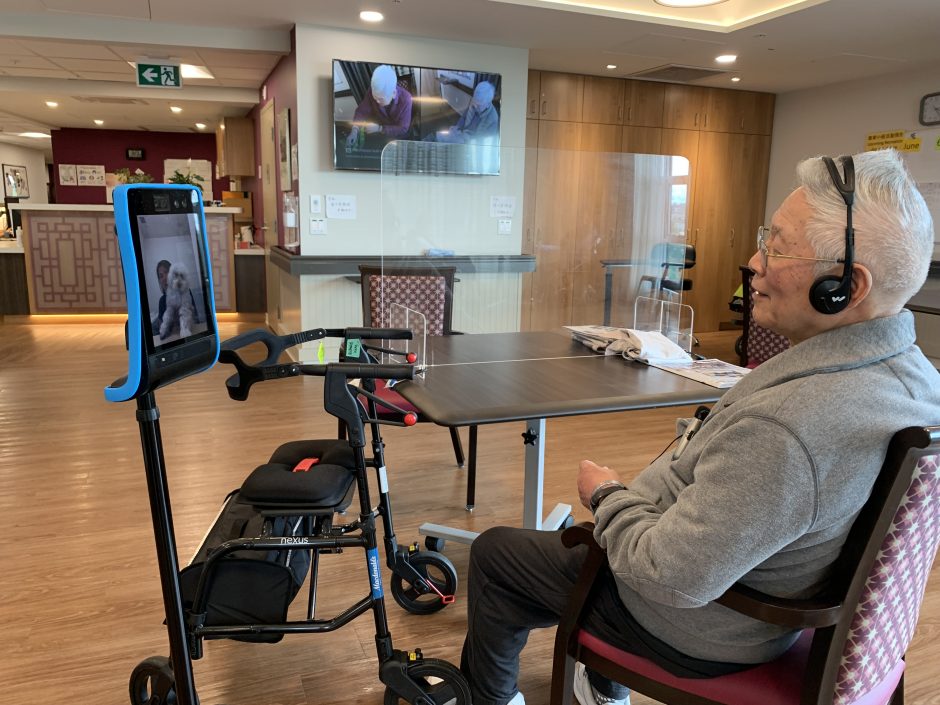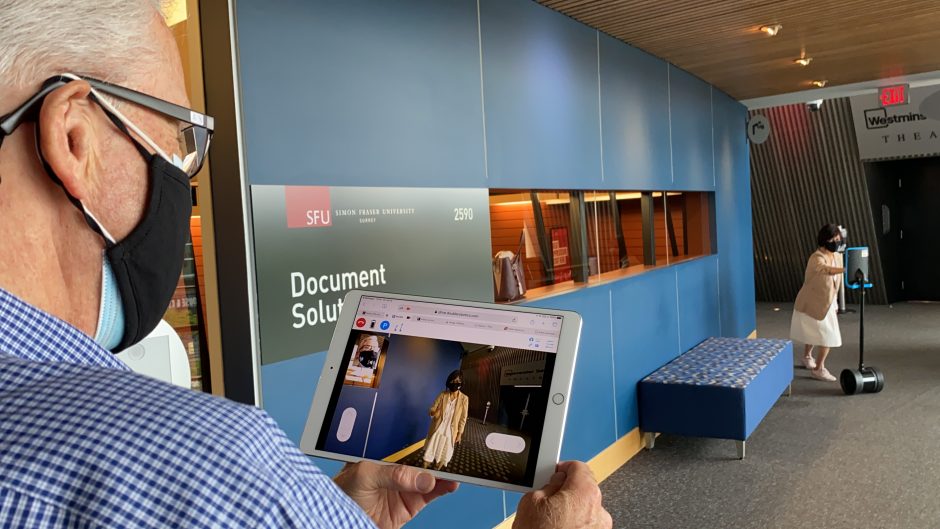The name Helen didn’t really work. Neither did other typical names, such as David or Susan. But Giggles just seemed the perfect fit to Jim Mann. He is a patient partner — diagnosed with early-onset Alzheimer’s 15 years ago — and study co-lead for a new project looking at how robots can be used to reduce social isolation in long-term care (LTC). Jim grins as he says, “The robot will really bring happiness and the opportunity to laugh or smile, so what better way to illustrate than to be able to say, ‘Here comes Giggles!’”
Giggles is one of 10 robots that are part of a new project to support virtual family visits, led by CHÉOS Research Associate Dr. Lillian Hung. Dr. Hung is the founder and head of IDEA Lab (Innovation in Dementia and Aging), assistant professor at the UBC School of Nursing, and a clinical nurse specialist at Vancouver Coastal Health.
“During the pandemic, there was a huge demand for virtual care. But through conversations with patient and family partners, we learned that it was very difficult to book those virtual care meetings,” explains Dr. Hung. “The biggest problem is staffing. You need them to help facilitate virtual visits using iPads.”
On top of that, most residents are not able to hold an iPad themselves, not all staff are comfortable with technology, and there can be frustration on all sides when there are connectivity issues. So, after several years working on the iPad Project, Dr. Hung and her team wanted to take it one step further and come up with a more self-sufficient way for residents to easily connect with their families. (iPad Project resources are available here.)
Technology can help make connections more easily
That’s where Giggles comes in. Jim has been able to test drive Giggles with residents at Minoru Residence in Richmond. “I was here in Surrey, and I was able to virtually maneuver the robot in Richmond,” says Jim. “It was phenomenal to think that is possible, and it was especially wonderful to see the reaction of some of the residents. They interacted with me as if I were there in person.”
The so-called telepresence robot just needs to be close to the resident, with no staff intervention necessary. Dr. Hung explains, “The resident doesn’t have to do anything. The face of the family member comes on and they start to talk. The family will easily be able to adjust the robot remotely, moving it up and down, or even driving it around the room.”
Charlie Lake, a UBC biomedical engineering student on the study team, is helping with robot technical support. He adds, “It’s very smart about how it drives around. If you try to drive it into the wall, or something else, it will come to a halt.”
Advances in care for people living with dementia
Jim has been an advocate for people living with dementia since long before his own diagnosis. He cared for his mother through her Alzheimer’s diagnosis. When she was in long-term care, he says it became quite clear there was a lot of stigma. As well, there was a lack of education on how to interact with people living with dementia. He recalls witnessing a staff member mocking a resident who was disoriented and couldn’t find her way back to her room, as one example.
Recently, the retired marketing and communications professional was in the audience for a panel discussion on long-term care. “I stood up and shared that my mother passed away in 2007, and here we are years later and we are still talking about some of the issues that were evident when she was in long-term care.”

That’s why he devotes much of his free time contributing his knowledge and lived experience to projects such as this one. The 73-year-old is especially excited about how technology can have such a positive impact. “It means we are treating residents and patients as individual people, and giving them agency to be able to roll up to mom or dad, or a brother or sister, and say ‘Hi! Now I can see what you are having for lunch, so let’s talk over lunch’,” explains Jim. “That interaction would be so comfortable and familiar, and so much more than what you would get from having to hold an iPad, or talking on the phone.”
Dr. Hung echoes this sentiment. The robot technology is simple to use. Even residents who don’t have cell phones have been able to engage virtually in a meaningful way. She shared the story of an older person with dementia who was able to visit with his brother. “It was so easy and the resident didn’t have to do anything. He just sat in front of the robot and his brother popped up. You should have seen his face — big eyes, huge smile. That quality of life is priceless.”
Staff also benefit from easy-to-use technology
The health care workers are also excited about the way robot technology could enhance their jobs. Dr. Hung shares, “You can only retain staff if they feel that the job is rewarding and fulfilling. And when they are able to easily help a resident and see the joy on their faces, it makes the staff feel good.”
Some health care workers aren’t confident with technology, and that is Lake’s biggest challenge. He trains study participants to use the robots. “A lot of older adults and health care workers will constantly tell me they aren’t that good with technology. But it’s my job to make sure I can give them confidence to succeed.”
There are several other issues that need to be addressed before the project expands further, including infection control, privacy and confidentiality, and guidelines on where the robots are allowed to go.

Technology has many potential applications
Just a few months into the start of this three-year project, the team is already seeing so many additional possibilities. Consults with physicians are a lot easier to facilitate with the robot, and researchers are using the robots to interview residents who are involved with other projects.
Jim works on Dr. Hung’s other projects too and he is also on a committee with a national network that develops technology for healthy aging. He is excited about how technology is transforming care for the better, and he enthusiastically calls the robots a “win, win, win” for residents, families, and staff.
“I like to think I’m making a contribution while helping myself stay as well as I can. I am challenged by some of this work, but I get so much out of it. Lillian challenges me, I challenge her, the projects are a challenge. But it’s offered so many eye-opening experiences for me. It’s been really a lot of fun.”



